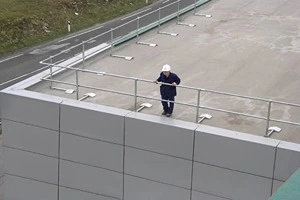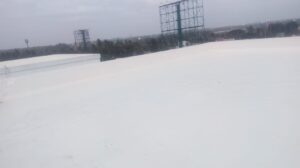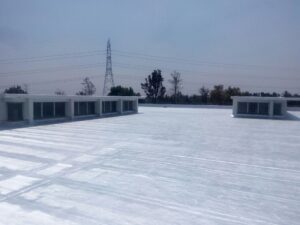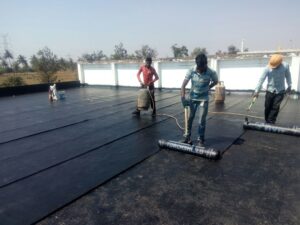
1.Flat Roof Waterproofing – importance
Flat roof waterproofing is crucial for protecting buildings from water damage and leaks. Flat roofs are common in commercial and residential buildings, and they are more susceptible to water damage compared to pitched roofs due to their design. Water can pool on flat roofs, which can lead to leaks, structural damage, and mold growth if not properly waterproofed.
Here are some reasons why flat roof waterproofing is important:
- Prevents water damage: Water damage can cause significant structural damage to buildings and can also damage the contents inside. Waterproofing a flat roof can prevent water from seeping through and causing water damage.
- Protects against leaks: Flat roofs are prone to leaks because water can pool on the surface and penetrate the roofing material. Waterproofing the flat roof can prevent leaks from occurring, which can save money and time on repairs and maintenance.
- Extends the lifespan of the roof: A properly waterproofed flat roof can last longer than a non-waterproofed one. By preventing water damage and leaks, the roof’s lifespan can be extended, saving building owners money in the long run.
- Improves energy efficiency: A waterproofed flat roof can help to insulate the building, keeping it cooler in the summer and warmer in the winter. This can lead to energy savings and lower utility bills.
- Prevents mold growth: Water damage can create a breeding ground for mold and mildew. A waterproofed flat roof can prevent water from seeping in and reduce the risk of mold growth.
2. available systems for Flat Roof Waterproofing
There are several types of waterproofing systems available for flat roofs. The type of system chosen will depend on various factors such as the roof’s size, the material, and the intended use of the building. Here are some of the commonly used flat roof waterproofing systems:
- Built-up Roofing (BUR): This system is also known as a tar and gravel roof. It consists of multiple layers of bitumen and fabric or felt, which are bonded together with hot tar or asphalt. A layer of gravel or stone is placed on top for protection against UV rays. This is an outdated system and are currently rarely found.
- Modified Bitumen: This system is similar to BUR, but it uses a modified bitumen material that is easier to handle and install. It can be torch-applied, cold-applied, or self-adhering like APP (Atactic Polypropylene) modified, torch-on bituminous plastomeric waterproofing membranes.
- Single-ply Membrane: This system uses a single layer of synthetic material such as PVC, TPO, or EPDM (Ethylene propylene diene monomer). The membrane is heat-welded or glued to the roof’s surface and can be mechanically attached or ballasted.
- Liquid-applied Membrane: This system uses a liquid coating that is applied to the roof’s surface and dries to form a continuous membrane. The coating can be made of various materials such as acrylics, PU (polyurethanes), or silicones.
- Spray Polyurethane Foam (SPF): This system uses a spray foam insulation that is applied directly to the roof’s surface. This system uses a spray-applied foam insulation that also acts as a waterproofing layer. It is energy-efficient and can be applied to irregularly shaped roofs. However, it may require frequent maintenance and can be vulnerable to ultraviolet (UV) light damage. The foam needed to be coated with a protective layer of elastomeric coating immediately after installation of SPF also called as PUF (Polyurethane Foam Insulation)
- Metal Roofing: Metal roofs, such as standing seam or corrugated metal, can also be used for flat roof waterproofing. They are durable, lightweight, and long-lasting, and can be coated with a waterproofing material for added protection. However, they can be noisy during heavy rain and can be vulnerable to corrosion.


3. selection of Flat Roof Waterproofing system
The selection of a flat roof waterproofing system depends on various factors, such as the climate, building design, budget, and required performance. Here are some factors to consider when selecting a flat roof waterproofing system:
- Climate: The climate of the region where the building is located is a crucial factor in the selection of a flat roof waterproofing system. For example, in areas with high rainfall, a system with high water resistance is essential. In areas with high UV exposure, a system with UV protection is necessary.
- Building Design: The design of the building can also affect the selection of a flat roof waterproofing system. Factors such as the size and shape of the roof, the presence of penetrations, and the weight capacity of the roof need to be considered.
- Budget: The available budget is an important factor in the selection of a flat roof waterproofing system. Some systems, such as built-up roofing, may be less expensive initially but require more maintenance and repairs in the long run. Other systems, such as single-ply membrane or liquid applied membrane, may be more expensive initially but require less maintenance over time.
- Performance Requirements: The required performance of the flat roof waterproofing system should also be considered. For example, if the building has a green roof or a rooftop garden, a system with high root resistance is necessary. If the building has high foot traffic, a system with high puncture resistance is important.
- Installation and Maintenance: The ease of installation and maintenance requirements of the flat roof waterproofing system should also be considered. Some systems, such as spray polyurethane foam, require specialized equipment and training for installation. Other systems, such as metal roofing, may require more frequent inspections and maintenance.
Selecting the right flat roof waterproofing system requires careful consideration of various factors. Consulting with experienced professionals can help ensure that the system meets the specific needs of the building and provides long-lasting protection against water damage and leaks.
GEOLIZ WATERPROOFERS PVT. LTD.
Waterproofing Products & Services Guide
For details on other waterproofing products & Services


